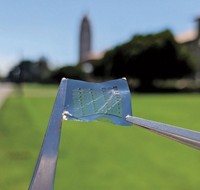Advertisement
Grab your lab coat. Let's get started
Welcome!
Welcome!
Create an account below to get 6 C&EN articles per month, receive newsletters and more - all free.
It seems this is your first time logging in online. Please enter the following information to continue.
As an ACS member you automatically get access to this site. All we need is few more details to create your reading experience.
Not you? Sign in with a different account.
Not you? Sign in with a different account.
ERROR 1
ERROR 1
ERROR 2
ERROR 2
ERROR 2
ERROR 2
ERROR 2
Password and Confirm password must match.
If you have an ACS member number, please enter it here so we can link this account to your membership. (optional)
ERROR 2
ACS values your privacy. By submitting your information, you are gaining access to C&EN and subscribing to our weekly newsletter. We use the information you provide to make your reading experience better, and we will never sell your data to third party members.
Materials
Perovskites tapped for flexible nonvolatile memory
Researchers make memory devices out of perovskites by taking advantage of defects in the material’s crystal
by Prachi Patel
May 3, 2016

Thanks to their superb ability to convert light to electricity, perovskites have led to solar cells with greater than 22% efficiency—comparable to commercial silicon solar cells—in a few short years. To hone the material’s performance, researchers do their best to eliminate crystal defects in it. Now, however, materials scientists have turned this problem into a strength, using perovskites to make bendable memory storage devices that rely on the crystal defects to work (ACS Nano 2016, DOI: 10.1021/acsnano.6b01643).
Nonvolatile memory retains its data even when its power supply is turned off. Computer hard drives are a kind of nonvolatile memory made of magnetized materials. These materials show magnetic hysteresis, a lag in response to an applied magnetic field, which allows them to remain slightly magnetized in one of two magnetic states—the 0s and 1s of digital data—even when the power is turned off and the field removed.
Some companies are now working to store data using two electrical resistance states, because resistive memory promises to be faster, denser, and more energy efficient than magnetic memory. Analogously, the technology requires a material that shows current-voltage hysteresis, a lag in response of current to voltage changes.
Perovskites, it turns out, show current-voltage hysteresis because of the same crystal defects that cause headaches in solar cell applications. “Defects are not good for solar cells, but they are essential in our memory devices,” says Jang-Sik Lee, a materials scientist and engineer at Pohang University of Science & Technology.
Lee and colleague Chungwan Gu deposited a thin film of the perovskite methylammonium lead triiodide on a flexible plastic substrate coated with a transparent indium tin oxide electrode. They deposited gold electrodes on top of the perovskite. This forms a basic resistive memory device, Lee says. Applying a positive voltage (1 V) sets the device to a low resistance ”on” state, and applying an equivalent negative voltage resets it to a high resistance ”off” state.
The researchers measured the two resistance states for more than 2.5 hours and found no degradation in the device’s ability to switch between states, meaning the device could hold information for at least that long. They now plan to test the devices for several weeks.
Given how easy and cheap it is to make perovskites, “these flexible devices could be used in low-cost stretchable and wearable electronics of the future,” Lee says.
One limitation to perovskite memory is its slow response speed, says Jinsong Huang of the University of Nebraska, Lincoln, who has also studied the resistive switching effect in perovskites. The devices respond in milliseconds, whereas state-of-the-art flash memory works in nanoseconds. But the low cost still makes it appealing for new applications like wearables where the low speed is not a big problem.
Perovskites are excellent candidates for resistive memory devices, says Nam-Gyu Park of Sungkyunkwan University. “This work provides very promising results for the next-generation flexible electronic devices,” he says.





Join the conversation
Contact the reporter
Submit a Letter to the Editor for publication
Engage with us on Twitter